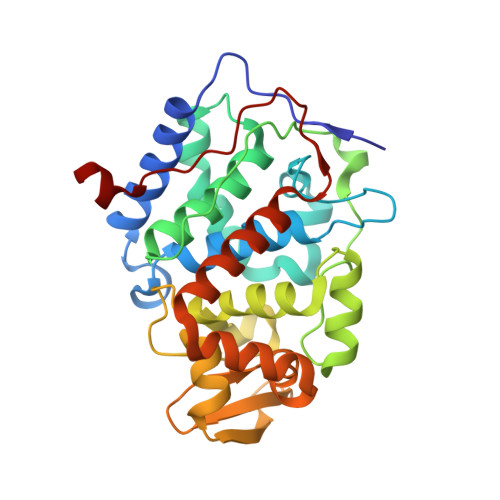High-resolution crystal structures and spectroscopy of native and compound I cytochrome c peroxidase
Bonagura, C.A., Bhaskar, B., Shimizu, H., Li, H., Sundaramoorthy, M., McRee, D.E., Goodin, D.B., Poulos, T.L.(2003) Biochemistry 42: 5600-5608
- PubMed: 12741816
- DOI: https://doi.org/10.1021/bi034058c
- Primary Citation of Related Structures:
1ZBY, 1ZBZ - PubMed Abstract:
Cytochrome c peroxidase (CCP) is a 32.5 kDa mitochondrial intermembrane space heme peroxidase from Saccharomyces cerevisiae that reduces H(2)O(2) to 2H(2)O by oxidizing two molecules of cytochrome c (cyt c). Here we compare the 1.2 A native structure (CCP) with the 1.3 A structure of its stable oxidized reaction intermediate, Compound I (CCP1). In addition, crystals were analyzed by UV-vis absorption and electron paramagnetic resonance spectroscopies before and after data collection to determine the state of the Fe(IV) center and the cationic Trp191 radical formed in Compound I. The results show that X-ray exposure does not lead to reduction of Fe(IV) and only partial reduction of the Trp radical. A comparison of the two structures reveals subtle but important conformational changes that aid in the stabilization of the Trp191 cationic radical in Compound I. The higher-resolution data also enable a more accurate determination of changes in heme parameters. Most importantly, when one goes from resting state Fe(III) to Compound I, the His-Fe bond distance increases, the iron moves into the porphyrin plane leading to shorter pyrrole N-Fe bonds, and the Fe(IV)-O bond distance is 1.87 A, suggesting a single Fe(IV)-O bond and not the generally accepted double bond.
Organizational Affiliation:
Program in Macromolecular Structure, Department of Molecular Biology and Biochemistry, University of California, Irvine, California 92697-3900, USA.















